The Thirteenth USA National ARDF Championships
And Seventh IARU Region 2 ARDF Championships
Asheboro, North Carolina, October 9 - 13, 2013
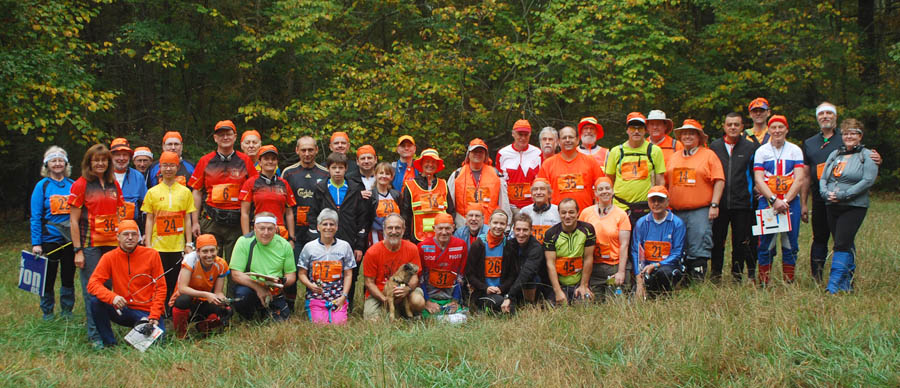
Competitors on Sunday morning before the 80-meter event.
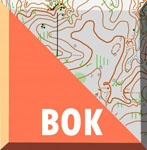
For the second time, the Tar Heel State has played host to the ARDF championships of USA. In 2006, the 5300-acre of William B. Umstead State Park next to Raleigh-Durham airport was the site for all events. This time, the events were 65 miles to the west and our national championships were combined with those of International Amateur Radio Union (IARU) Region 2, which encompasses North and South America.
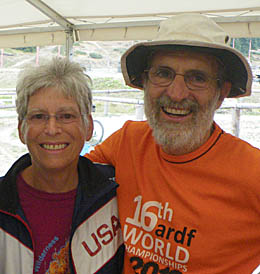 North Carolina warms up fast as spring progresses and the locals say that it becomes too hot for orienteering activities through the month of September. So this year's events took place during the third week and weekend of October in the 5025-acre Birkhead Wilderness Area of the Uwharrie National Forest, just south of Asheboro. Backwoods Orienteering Klub (BOK), which claims to make the best O-maps in the world, supplied updated course maps for all of the championship courses.
North Carolina warms up fast as spring progresses and the locals say that it becomes too hot for orienteering activities through the month of September. So this year's events took place during the third week and weekend of October in the 5025-acre Birkhead Wilderness Area of the Uwharrie National Forest, just south of Asheboro. Backwoods Orienteering Klub (BOK), which claims to make the best O-maps in the world, supplied updated course maps for all of the championship courses.
Meet Director for the 2013 championships was Joseph Huberman, K5JGH, who is also the President of BOK. His wife, Ruth Bromer, WB4QZG (both at right) was Registrar. She did the computer work, which included registrations (all online this time), order of starts, electronic scoring and results tabulations. Ruth medaled at the ARDF World Championships in 2010 and 2012.
All of the courses were designed by Nadia Scharlau (at left), who learned ARDF as a youth in her native Russia. Now a resident of Cary, NC, she has competed four times on ARDF Team USA and in 2006 was the first USA team member to win a medal at the World Championships.
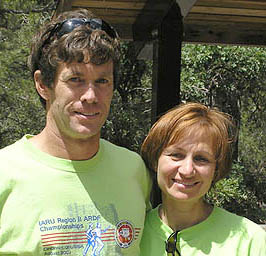 In charge of setting out all of the course transmitters (a total of 42 during the five sessions) was Charles Scharlau, NZ0I (also at left). He discovered ARDF in the Puget Sound area of Washington State and competed in our national Championships for the first time in 2001. He then went on to represent USA at the World ARDF Championships four times in the last decade.
In charge of setting out all of the course transmitters (a total of 42 during the five sessions) was Charles Scharlau, NZ0I (also at left). He discovered ARDF in the Puget Sound area of Washington State and competed in our national Championships for the first time in 2001. He then went on to represent USA at the World ARDF Championships four times in the last decade.
As in many European countries, USA's national championships are open, meaning that competitors visiting from other countries are welcome. The visitors compete for individual medals in an overall division that includes everyone. This year, visitors came from China, Germany, Russia, Sweden, Ukraine and United Kingdom.
ARDF in the Appalachians
The headquarters hotel for this year's championships was the Comfort Inn in Asheboro, where many of the competitors stayed. Early arrivers came in Tuesday, October 8 and met near the lobby at suppertime, where they checked in and received commemorative souvenirs.
For Wednesday's practice sessions, everyone drove to Gray Owl Road in the southern tip of Asheboro, where Joseph and Ruth's new home was under construction. It's right on the edge of the Uwharrie National Forest with a canopy view. Workers were installing metal roof panels as practice sessions started and ended in the back yard. The remnants of Tropical Storm Karen had passed through two days earlier, but there was only occasional light rain and mostly cloudy skies on this day.
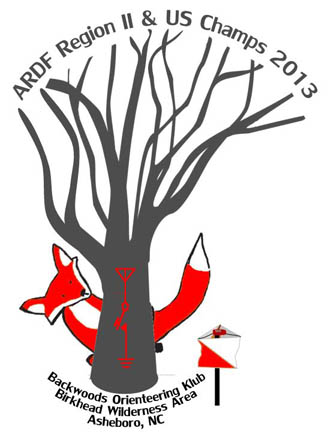 Snakes, ticks and wild mammals aren't problems in North Carolina during October, but it was bow-and-arrow hunting season in these forests. Therefore, everyone was asked to wear some bright colors for safety. The organizers provided vivid orange headcovers that were plain to see at a distance, even in the cloudy weather.
Snakes, ticks and wild mammals aren't problems in North Carolina during October, but it was bow-and-arrow hunting season in these forests. Therefore, everyone was asked to wear some bright colors for safety. The organizers provided vivid orange headcovers that were plain to see at a distance, even in the cloudy weather.
Thursday was devoted to the new sport of foxoring, which took place in the Thornburg Tract. It includes a 160-acre 19th century farmstead that was purchased by the US Forest Service for restoration in 2005. As a gateway to the Birkhead Wilderness, it was an ideal start and finish area. Because of a federal government shutdown, the Thornburg farm was unstaffed and the gate to the parking area was closed. Fortunately there was some parking near the gate and along the muddy dirt road.
Foxoring is an 80-meter event that helps ARDF enthusiasts to improve their orienteering skills. At the start, they get a map marked with circles for at least ten transmitters, plus the start and finish beacon locations. The very low power foxoring transmitters are in or very close to the circles as marked on the maps. Competitors navigate close to transmitters by means of the map and then complete the final approach by radio direction finding.
Foxoring transmitters are very small and are usually concealed in trees, without a flag. As in all other events, the designated transmitter numbers to be found by competitors in each category are announced in advance.
It is standard practice in formal ARDF competitions for the start and finish to be in separate locations. The finish is plainly marked on the map and there is a continuously-operating transmitter on a separate frequency to aid in navigating there. The length of a course is defined as the shortest viable route from the start line via the transmitters in optimum order to the finish line. To that distance is added ten times the total upward elevation change (climb) to get the "effective course length."
For Thursday's foxoring, the effective course lengths ranged from 4.6 km for W60 category to 7.3 km for M21. There was occasional light rain, but running conditions in the forest were very good. Everyone did well, even those who had never done foxoring before.
More participants arrived Friday morning in time for the sprint competition. In the sprint, as in all other competitions except foxoring, there are no markings for the transmitters on the maps. The sprint has twice as many transmitters as a classic event, but the course is much shorter. The first group of five transmitters are all on one frequency, transmitting for 12 seconds each in a 60-second cycle. After finding the ones required by category in that group, competitors find the required ones in a second group of five on a different frequency, then they head for the finish line.
Each day, participants received their full-color orienteering maps ten minutes before start time. Most of them taped their maps to a lightweight and rigid flat surface, such as a discarded political campaign sign. The Germans prefer corkboards with colored pushpins to mark their bearing crossings. GPS and other electronic supports such as Google Maps are prohibited on the courses.
This sprint starting corridor went from the long driveway of the Huberman property into the wilderness. The finish was next to their new home. Effective course lengths ranged from 1.7 km for W60 and M70 to 2.9 km for M21.
The sprint is a relatively new event for USA's foxtailers. This was only the second year that it has been included in our national championships. Eastern Europeans are much more experienced in this event and it showed. For instance, Volodymyr Gniedov of Ukraine found all ten transmitters and completed the course in less than 22 minutes.
The Main Events
The last of the competitors arrived late Friday. Everyone found the way back to the Huberman property on Saturday morning for the main two-meter event. They trekked out a trail westward from the house about 700 meters to the starting area in a large section of forest that they had not seen before. The two-meter starting corridor went past an abandoned farmhouse and into the wilderness.
Two meters is the band where stateside foxhunters are most experienced. Almost everyone had a good day on the course with most of them finding all required transmitters and only one person exceeding the three-hour time limit. Best USA time of the day was 59 minutes for four required transmitters by Vadim Afonkin, KB1RLI.
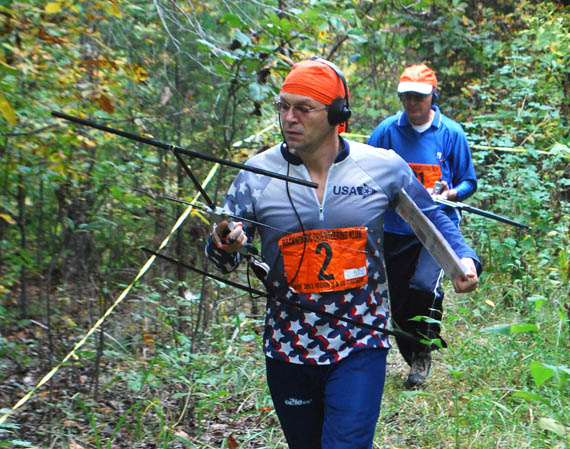
Vadim Afonkin KB1RLI heads into the forest from the two-meter event starting line, followed by Harley Leach KI7XF. Click for more photos.
It was Something Different for supper on Saturday night. Something Different is the name of the restaurant where everyone gathered to eat, receive medals and exchange token gifts. It took a lot of effort for Joseph and Ruth to get government officials to provide invitations and visas for the Ukrainians, so everyone laughed and cheered when Mariana Marynchenko, their representative and translator, gifted them a beautiful hand-carved gavel as a "persuader" to help them eliminate red tape in the future.
Sunday's 80-meter event required everyone to drive a half-mile rutty road into the woods to a clearing at the trailhead for Robbins Branch Trail. Then they walked a half-kilometer up the trail to the starting point. Weather was cool with heavy clouds. This was the longest course of the championships and it had the largest map, printed on 11 x 17 inch paper. Effective course length ranged from 5.2 km for W60 and M70 to 9.3 km for M21.
The signal reflections that can plague transmitter hunters on two meters in hilly and mountainous areas are non-existent with 80-meter groundwave propagation, so it is normal for competitors' times to be shorter on this band. Most of the performances on Sunday were better than on Saturday, even though the course was longer.
After finishing, competitors walked down the trail to the parking area to download their scoring "sticks" and refresh while results were tabulated. Thanks to electronic scoring, it was possible to hold the 80-meter medal ceremony immediately after the hunt concluded, to accommodate participants who had to rush to the airport for flights to home that evening.
Since Ruth and Joseph were not the course designers and had no advance knowledge of transmitter placement, they were able to compete for medals in all of the other formal competitions. Other volunteers from BOK handled the start and finish logistics and timing.
Taking first place awards among USA's competitors were Vadim Afonkin, KB1RLI (M40 2m, 80m, foxor); Ruth Bromer, WB4QZG (W60 2m, 80m, foxor); Bob Cooley, KF6VSE (M70 foxor); Marjorie Garrett, KJ4ZKC (W50 2m, 80m); Jay Hennigan, WB6RDV (M60 2m, 80m, sprint); Joseph Huberman, K5JGH (M60 foxor); Lori Huberman (W21 2m, 80m, sprint, foxor); Kuon Hunt, KB7WRG (W60 sprint); Harley Leach, KI7XF (M70 2m, 80m, sprint); Nicolai Mejevoi (M40 sprint); Alla Mezhevaya (W35 2m, 80m, sprint, foxor); George Neal, KF6YKN (M50 2m, 80m, sprint, foxor) and Csaba Tiszttarto (M21 sprint). Representing Canada were Valeri Gueorguiev (M50) and Nicholas Roethe, DF1FO (M60), who was first among Region 2 competitors on 2m and 80m.
Kudos to all of the organizers and volunteers who made these championships a big success. The courses were challenging and educating. Also thanks to everyone who attended for the interest, enthusiasm, and positive attitude that prevailed.
More than 90 photos of the championships are now in this Homing In Web site.
Individual results and additional event details are in the 2013 USA/R2 ARDF Championships Web page of the BOK site.
Portions of this report have been excerpted from my Homing In column in the May 2014 issue of CQ-Plus digital magazine.
Joe Moell KØOV
USA ARDF Coordinator
Text and photos copyright © 2014 Joseph D. Moell. All rights reserved.
 Go to First photo page of this event
Go to First photo page of this event
Go to Championships Foxhunting News -- Recent and upcoming ARDF championships events
Go to International-Style Foxhunting Comes To The Americas -- How we're getting the ball rolling
Go to Equipment Ideas for Radio-Orienteering -- Simple and inexpensive receiving and transmitting solutions
Go to Radio-Orienteering News for Southern California -- Results and stories of recent radio-orienteering events in southern California, plus announcements of upcoming ones.
Go to Foxhunting for Scouts -- Let's get the kids involved
 Back to the Homing In home page
Back to the Homing In home page
This page updated 29 March 2015


 North Carolina warms up fast as spring progresses and the locals say that it becomes too hot for orienteering activities through the month of September. So this year's events took place during the third week and weekend of October in the 5025-acre Birkhead Wilderness Area of the Uwharrie National Forest, just south of Asheboro. Backwoods Orienteering Klub (BOK), which claims to make the best O-maps in the world, supplied updated course maps for all of the championship courses.
North Carolina warms up fast as spring progresses and the locals say that it becomes too hot for orienteering activities through the month of September. So this year's events took place during the third week and weekend of October in the 5025-acre Birkhead Wilderness Area of the Uwharrie National Forest, just south of Asheboro. Backwoods Orienteering Klub (BOK), which claims to make the best O-maps in the world, supplied updated course maps for all of the championship courses.
 In charge of setting out all of the course transmitters (a total of 42 during the five sessions) was Charles Scharlau, NZ0I (also at left). He discovered ARDF in the Puget Sound area of Washington State and competed in our national Championships for the first time in 2001. He then went on to represent USA at the World ARDF Championships four times in the last decade.
In charge of setting out all of the course transmitters (a total of 42 during the five sessions) was Charles Scharlau, NZ0I (also at left). He discovered ARDF in the Puget Sound area of Washington State and competed in our national Championships for the first time in 2001. He then went on to represent USA at the World ARDF Championships four times in the last decade.
 Snakes, ticks and wild mammals aren't problems in North Carolina during October, but it was bow-and-arrow hunting season in these forests. Therefore, everyone was asked to wear some bright colors for safety. The organizers provided vivid orange headcovers that were plain to see at a distance, even in the cloudy weather.
Snakes, ticks and wild mammals aren't problems in North Carolina during October, but it was bow-and-arrow hunting season in these forests. Therefore, everyone was asked to wear some bright colors for safety. The organizers provided vivid orange headcovers that were plain to see at a distance, even in the cloudy weather.


